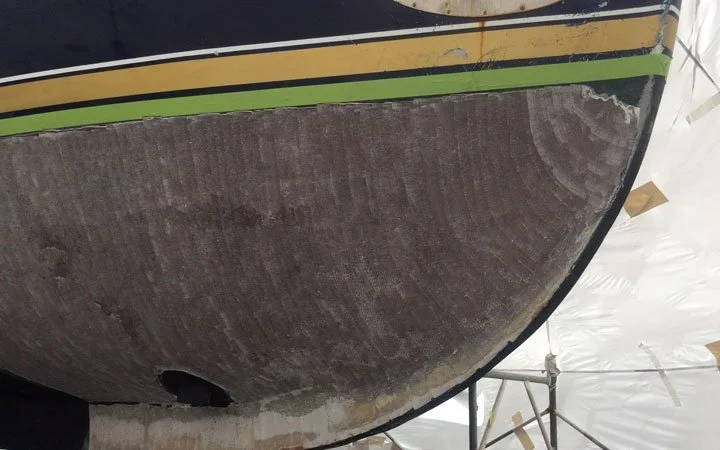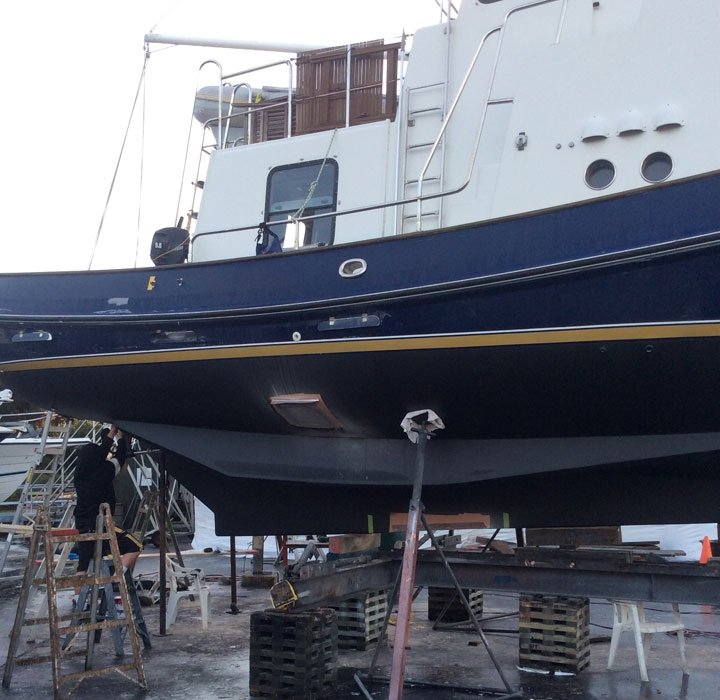
Osmosis Solutions
Osmosis Solutions offers a variety of specialty services from osmosis and gelcoat repairs to wooden hull planing, Propspeed application, antifouling and detailed exterior boat valet services. We are experts in everything to do will hull repair, maintenance and osmosis prevention.
We specialise in the following repair services:
Full Bottom osmosis repairs incorporating
HotVac Hull Cure technology*
Individual osmosis repairs
Gelcoat blister repairs
General GRP repairs
Other services we offer include:
GRP laminate inspections
Re-antifouling of underwater areas
Prop Speed application
Planing for efficient removal of coatings on wooden craft
Exterior boat valet (polishing/varnishing) etc.
What is osmosis?
Osmosis is a common problem that affects fibreglass boat hulls over time. It occurs when water slowly penetrates the gelcoat, reacting with chemicals inside the laminate and forming acidic solutions. These create pressure pockets, often seen as small blisters on the hull surface. Left untreated, osmosis can weaken the structure of your boat, reduce performance, and negatively impact its value. At Brin Wilson Boats, we have the expertise and facilities to resolve osmosis problems completely. You can watch our short video about osmosis here.
My boat has osmosis.
What should I do?
If you think your boat has osmosis, get in touch with us as soon as you can. Our team carefully diagnoses the extent of the damage, removes affected areas, and rebuilds the hull with proven materials and processes. Once repaired, the hull is protected with high-quality coatings to guard against future water ingress.
The stages of osmosis repair are:
-
The first stage of the 6-step process is the removal of coatings, gelcoat, and the contaminated laminate. This is a vital part in the repair process and sets the stage for the rest of the project.
The plane is designed to plane flat surfaces as well as concave and convex curves quickly and easily. The depth of cut can be adjusted to remove the contaminated laminate. It is fitted with a vacuum system to ensure that all waste materials are collected. The hull is thoroughly inspected and additional areas, or sections of the hull inaccessible by the planning machine, are ground out.
-
After planing, the boat is thoroughly washed with fresh water to remove any salt crystals or moisture on the surface, and the vessel is carefully inspected for any additional areas that may require further attention. A sophisticated moisture meter, which allows us to take readings from just below the surface to deep into the laminate, helps us to identify areas that require further drying, which is essential before new glass is applied. The excessive wet areas are mapped out on the boat, and the Hot Vac system, which uses a hot blanket and vacuum, vaporises impurities and moisture from the hull, which is a vital step - not only to achieve post curing, but also helping to reduce drying time to just days rather than weeks or even months. Hot Vac blankets hug the hull, forming an air tight seal which can be applied to any hull profile. The adjustable controls allow us to alter the temperature to suit your hull construction.
-
Once dried, the entire hull is skim ground to remove any surface contamination and is again washed with fresh water. A minimum of 2 layers of chopped strand mat are applied by hand using our own Derakane Vinylester resin. The glass matt is bristle rolled and special care is taken to remove all the air in the new laminate.
The 2 new layers of glass not only builds back strength that was lost due to the osmosis in the hull, but is the first barrier protection against the reoccurrence of osmosis.
-
This is a very important part of the finishing process and is by far the most labour intensive. Each full bottom osmosis project is carefully and skillfully faired to restore the hulls shape, and in many cases, improving the hull's curvature to better than new condition.
Our specialised fairing machines are adaptable to most curves and surfaces, and help to reduce the fairing time. Hollows, radius and pin holes are spot filled where necessary. Once the fairing process is complete, there is absolutely no evidence of our full bottom osmosis repair work.
-
Once the boat has been faired, the waterline is carefully taped and 2 coats of epoxy-based primer are hand rolled onto the hull. The epoxy primer helps to provide a barrier protection against osmosis and also fills any pin holes in the fairing product.
Between the first and second coat, the hull is carefully inspected for any areas that may require additional spot fills. The first coat of primer is left to cure over night and sanded to ensure a good key. A further 2 undercoats are rolled on and allowed to tack before an antifoul of your choice is applied along with zincs and PropSpeed.
Congratulations, you're osmosis has been removed, the hull is protected from future contamination, and your vessel is ready to launch!
-
Originally developed by Mike Menzies, step 4 uses an exclusive coating called Thixo - a process with a track record of over 25-years of success, and one that is now used exclusively by Osmosis Solutions.
This Vinylester-based, thick gel-type product is rolled and screened over the glass laminate to create a thick film which provides an additional barrier against future osmosis. Also in this same process, a final Vinylester based product called Micro is rolled and screened over the Thixo coating, creating not only another barrier, but a product that can be used in the refairing of the hull.
“For anyone wanting to protect their investment and ensure carefree boating, we cannot recommend Osmosis Solutions enough.”
TONY, OWNER OF 1992 BENETEAU 370 TAMISE








